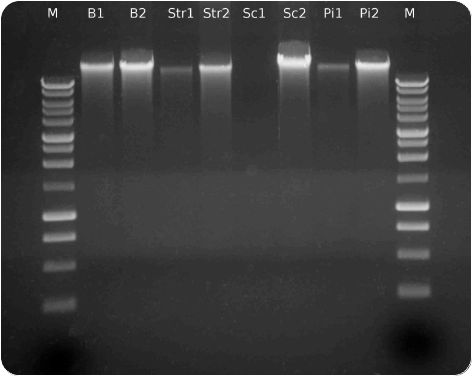Gram Plus & Yeast Genomic DNA Purification Kit
Kit for isolation of total DNA from hard to lyse bacteria (Gram+, archaea) and from yeasts.
Mechanical, bead based lysis.
Detailed Product Description
English Version
 Detailed Reference Manual (English Version Only)
Detailed Reference Manual (English Version Only)Introduction
The Gram Plus & Yeast Genomic DNA Purification Kit allows to isolate high quality DNA from several hard-to-lyse bacteria without specific enzymatic cell-wall treatment.The kit features a universal homogenization and cell lysis method by combining mechanical trituration using glass beads of different diameters in a detergent rich environment. For preventing excessive fragmentation of genomic DNA due to mechanical lysis treatment, special optimizations were applied to the lysis buffer, thus allowing to achive DNA isolation with maximum yield and best possible integrity.

Figure 1: Comparison: Non-mechanical DNA extraction vs. mechanical, bead based genomic DNA extraction. DNA was extracted from various hard-to-lyse, gram positive bacteria and from a yeast strain. Each strain was isolated in duplicate. This comparison demonstrates the kit's capability to isolate intact, minimally sheared DNA from various hard-to-lyse microorganisms, despite extensive mechanical treatment and harsh cell disruption.
Lane 1: Non-mechanical DNA extraction: Bacterial & Yeast Genomic DNA Kit, isolation without mechanical lysis and without specific enzymes.
Lane 2: Mechanical, bead based DNA extraction: Gram Plus & Yeast Genomic DNA Purification Kit, isolation according to protocol and with Bead Tubes (glass beads), without specific enzymes
- B1 - Bacillus subtilis - non-mechanical extraction.
- B2 - Bacillus subtilis - mechanical bead extraction.
- Str1 - Streptomyces caespitosus - non-mechanical extraction.
- Str2 - Streptomyces caespitosus - mechanical bead extraction.
- Sc1 - Staphylococcus aureus - non-mechanical extraction.
- Sc2 - Staphylococcus aureus - mechanical bead extraction.
- Pi1 - Pichia pastoris - non-mechanical extraction.
- Pi2 - Pichia pastoris - mechanical bead extraction.
- M - Perfect PlusTM1 kb DNA ladder (EURx)
- Genomic DNA extraction from various phylogenetically different gram positive and gram negative bacterial species (e.g. environmental isolates) and from yeasts.
- Mechanical, bead based extraction. No treatment with specific cell-wall degrading enzymes required.
- Moderately sheared DNA is beneficial for PCR assays. Kit buffers were optimized to prevent excessive fragmentation. However, some individual optimization of mechanical treatment (cell disruption time) might be required, if DNA shearing has to be reduced to a minimum.
- Long term column and buffer storage without loss of quality enabled.
 PCR Logsheet
PCR Logsheet
